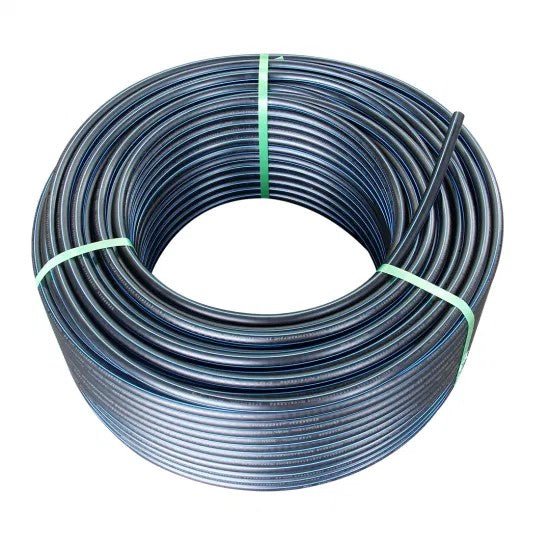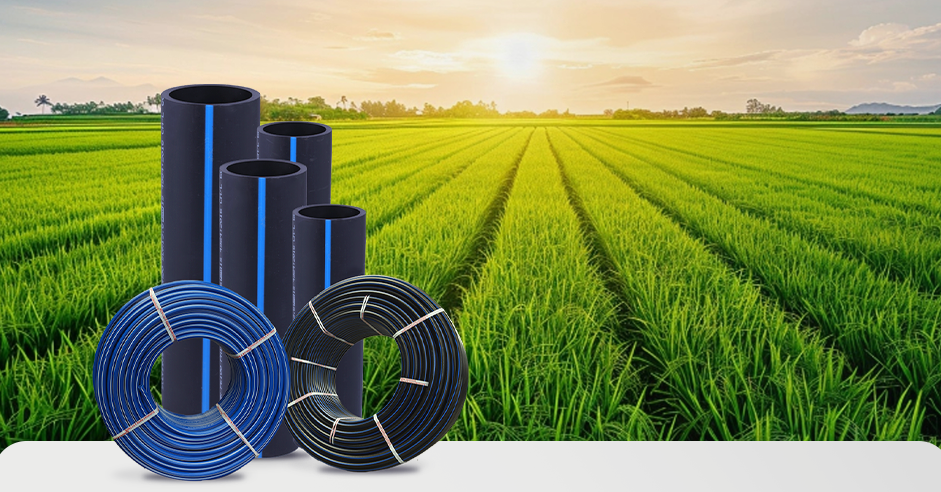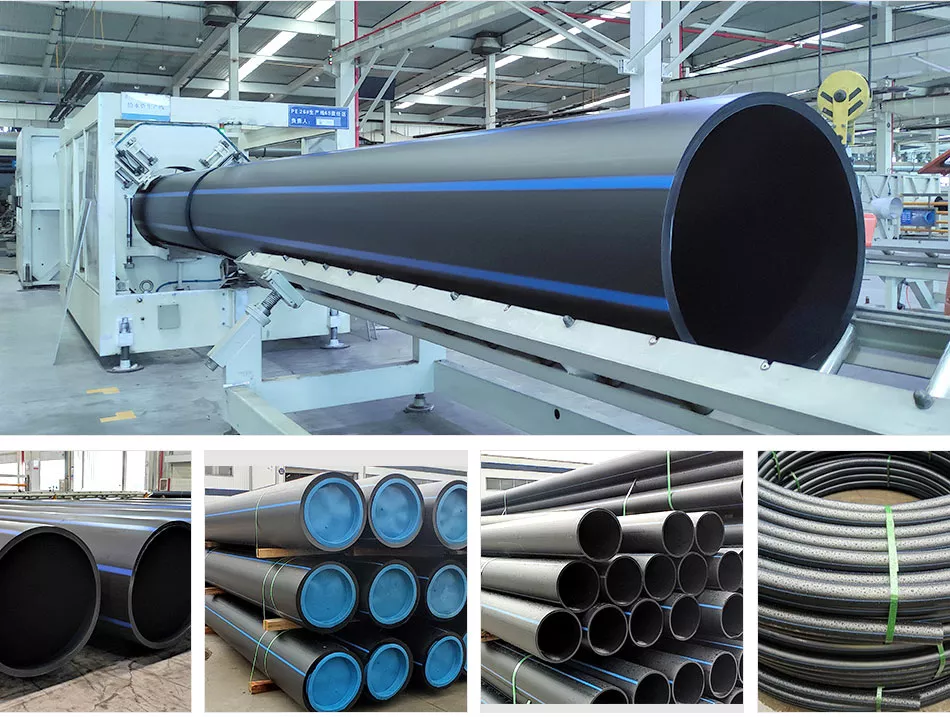Why Partnering with Pipe Supplier American Plastics Midland Ensures Trusted Solutions
Wiki Article
Check Out the Manufacturing Refine Behind High-Quality HDPE Pipe and Its Applications
The manufacturing procedure of high-grade HDPE pipelines is detailed and methodical. It begins with the selection of basic materials that improve efficiency. Following this, ethylene undertakes polymerization to develop resin, which is then shaped through extrusion. Quality control is vital, making sure that the last item fulfills rigorous standards. The trip of HDPE pipes doesn't finish with manufacturing. Their applications across different markets disclose a more comprehensive value worth checking out.Understanding HDPE: Features and Advantages

High-density polyethylene (HDPE) is a flexible polycarbonate recognized for its resilience and resistance to different ecological aspects. This material displays superb tensile stamina, making it appropriate for demanding applications. Its low-density framework adds to a light-weight product, assisting in convenience of managing and setup. HDPE also showcases remarkable resistance to chemicals, which reduces destruction when exposed to rough substances.
The material's low moisture absorption even more boosts its durability, making it perfect for use in pipelines and tank. Additionally, HDPE is resistant to ultraviolet (UV) radiation, making sure that items maintain their stability even when subjected to sunshine. Additionally, its adaptability permits for the creation of elaborate forms without endangering strength. The eco-friendly nature of HDPE, frequently derived from recycled products, includes in its charm, advertising sustainable techniques in manufacturing. Generally, these residential properties and advantages make HDPE a preferred selection for numerous commercial and consumer applications.
Resources Selection for HDPE Manufacturing
The option of raw materials for HDPE production is essential to verify the last item meets the preferred specs and top quality standards. High-density polyethylene (HDPE) is largely produced from polymerized ethylene, stemmed from nonrenewable fuel sources such as gas or petroleum. The high quality of these feedstocks considerably influences the mechanical and thermal residential properties of the last HDPE.Additives additionally play a substantial duty in boosting HDPE's performance, consisting of antioxidants, UV stabilizers, and colorants, which enhance resilience and resistance to environmental variables. The selection procedure need to consider not only the chemical make-up of the raw materials however also their handling qualities to ensure effective production.
Additionally, the sourcing of basic materials ought to focus on sustainability and compliance with ecological policies, as liable methods are necessary in today's market. Ultimately, careful basic material choice lays the foundation for generating premium HDPE pipes appropriate for diverse applications.
The Extrusion Process: Forming HDPE Pipe
The extrusion procedure plays a crucial role in forming HDPE pipelines, starting with precise material prep work techniques that guarantee excellent circulation and consistency. Just as important is the style of the die, which straight affects the final measurements and surface area top quality of the pipeline. Together, these variables add significantly to the performance and high quality of HDPE pipeline manufacturing.Product Prep Work Methods
Efficient production of HDPE pipelines starts with thorough product preparation techniques, particularly the extrusion procedure. During this stage, high-density polyethylene material is initial dried to remove wetness, making certain ideal circulation qualities. The material is after that fed into the extruder, where it undergoes home heating and melting, transforming right into a thick state. This home heating procedure is meticulously managed to keep the product's honesty and performance. The liquified HDPE is forced through a die, shaping it into a continual pipeline kind. Appropriate temperature level administration throughout extrusion is crucial, as it straight impacts the material's residential or commercial properties and the last product high quality. Look At This As soon as formed, the HDPE pipeline is cooled and reduced to defined lengths, prepared for succeeding handling and applications.Die Design Importance
Accuracy in die layout plays an essential function in the extrusion process of HDPE pipelines. The die serves as the final shaping tool, straight influencing the pipe's measurements, wall density, and surface finish. A properly designed die warranties uniform product circulation, decreasing defects such as abnormalities and weak points. The geometry of the die must be optimized to accommodate the details properties of HDPE, including its thickness and thermal actions during extrusion. Additionally, the cooling price of the product as it travels through the die can markedly influence the pipeline's structural stability. Investing in advanced die technology is crucial for makers aiming to create top quality HDPE pipelines that fulfill industry criteria and customer expectations.High Quality Control Steps in HDPE Production
Different aspects affect the quality of HDPE pipe manufacturing, efficient top quality control steps are important to ensure consistency and reliability in the final item (Midland TX HDPE Pipe Fittings in Stock). Trick quality assurance techniques consist of rigorous material examination, confirming that the raw polyethylene fulfills recognized requirements for purity and density. Throughout the extrusion process, specifications such as temperature level, stress, and cooling time are carefully kept track of to preserve dimensional precision and structural integrityFurthermore, post-production testing is essential; manufacturers usually carry out hydrostatic tests to assess the pipeline's stamina and resistance to stress. Visual examinations for surface area flaws further improve quality assurance. Qualification from relevant standards companies, like ASTM or ISO, provides an extra layer of credibility. By implementing these extensive quality assurance steps, manufacturers can minimize issues, improve efficiency, and look at this web-site make sure that the HDPE pipelines fulfill the details demands of numerous applications, eventually bring about client satisfaction and rely on the product.
Applications of HDPE Pipe Across Industries
HDPE pipes are made use of throughout different industries as a result of their longevity and versatility. In water circulation systems, they guarantee reliable delivery, while in wastewater management, they provide reputable options for waste transport. Furthermore, farming watering networks benefit from HDPE's resistance to deterioration and flexibility, making it an excellent choice for contemporary farming practices.
Water Distribution Systems
A considerable variety of markets rely upon high-density polyethylene (HDPE) pipelines for efficient water circulation systems. Recognized for their durability and resistance to deterioration, HDPE pipes are widely utilized in community supply of water networks, farming watering, and industrial applications. Their light-weight nature promotes easy handling and setup, decreasing labor prices and time. Additionally, HDPE pipelines can fit numerous stress levels, making them appropriate for both reduced and high-pressure systems. American Plastics HDPE Pipe Manufacturing. The adaptability of the product permits for seamless integration right into existing framework, decreasing the demand for substantial excavation. HDPE's resistance to chemical leaching assurances that the water supplied stays safe and clean, making it an ideal selection for maintaining the top quality of potable water throughout different markets.Wastewater Administration Solutions
Reliable water distribution systems additionally pave the means for ingenious wastewater monitoring options, where high-density polyethylene (HDPE) pipes play a considerable function. Renowned for their durability and resistance to rust, HDPE pipelines are excellent for carrying wastewater in different setups. Their versatility enables for easy installation in complicated atmospheres, lessening the demand for extensive excavation. Furthermore, HDPE's smooth interior surface reduces friction, enhancing flow prices and efficiency. These pipelines are also immune to chemical leaching, guaranteeing that impurities do not jeopardize the surrounding environment. Industries, municipalities, and treatment centers significantly rely upon HDPE pipes for their dependability and longevity, making them a favored selection for modern wastewater administration systems. This flexibility pipelines plumbing underscores the essential value of HDPE pipes throughout numerous applications.Agricultural Watering Networks
Agricultural watering networks benefit greatly from making use of high-density polyethylene (HDPE) pipelines, which supply effective and trusted water distribution to plants. HDPE pipes are lightweight, making them very easy to carry and install, while their adaptability allows for different setups in varied surfaces. These pipelines show outstanding resistance to corrosion, chemicals, and UV radiation, making certain sturdiness in extreme agricultural environments. In addition, their smooth interior surface lessens rubbing loss, maximizing water circulation and reducing energy expenses linked with pumping. The long life of HDPE pipes, commonly exceeding 50 years, adds to decrease maintenance and replacement costs. Farmers increasingly count on HDPE pipelines to improve irrigation performance and advertise sustainable agricultural practices, inevitably leading to enhanced crop yields and source conservation.
Future Fads in HDPE Pipe Technology
As the demand for sustainable and effective framework grows, advancements in HDPE pipe innovation are positioned to change numerous industries. Arising fads include the combination of clever modern technologies, such as sensing units and IoT abilities, which help with real-time surveillance of pipe conditions, lowering upkeep prices and avoiding leakages. Additionally, the development of advanced manufacturing techniques, such as 3D printing, is enabling the manufacturing of facility, tailored pipeline layouts that provide to details project requirements.The emphasis on recycling and circular economic climate techniques is driving the development of HDPE pipelines made from recycled materials, enhancing sustainability. Boosted jointing techniques, such as electro-fusion and mechanical fittings, are likewise enhancing installment efficiency and reliability. Finally, the expanding emphasis on environmental laws is pressing makers to embrace greener production processes, ensuring that HDPE pipelines not just satisfy industry criteria however also cultivate a more sustainable future for framework advancement.
Often Asked Questions
How Does HDPE Contrast to Other Plastic Products?
HDPE surpasses many various other plastic products regarding resilience, chemical resistance, and flexibility. Its reduced thickness and high tensile toughness make it optimal for numerous applications, often exceeding alternatives in both efficiency and durability.What Are the Ecological Effects of HDPE Manufacturing?
The ecological influences of HDPE production consist of greenhouse gas exhausts, energy intake, and potential contamination from making processes. In addition, incorrect disposal can bring about soil and water contamination, increasing concerns concerning long-lasting eco-friendly impacts.Can HDPE Pipeline Be Reused?
Yes, HDPE pipelines can be recycled. Several centers accept utilized HDPE for handling, transforming it right into brand-new items. This recycling adds to sustainability initiatives, decreasing plastic waste while saving sources and power in the production cycle.What Is the Life-span of HDPE Piping?

How Do Temperature Level Variants Impact HDPE Pipeline Performance?
Temperature level variations greatly influence HDPE pipe performance, affecting versatility and stamina. High temperature levels can cause softening, while low temperatures might create brittleness, eventually influencing the pipeline's sturdiness and viability for various applications in varied environments.Report this wiki page